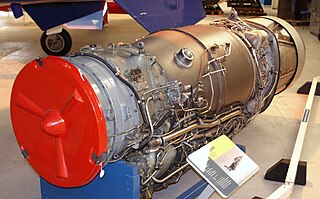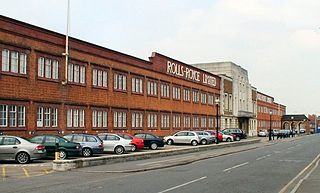Trent may refer to:
Trent may refer to:

The turbofan or fanjet is a type of airbreathing jet engine that is widely used in aircraft propulsion. The word "turbofan" is a portmanteau of "turbine" and "fan": the turbo portion refers to a gas turbine engine which achieves mechanical energy from combustion, and the fan, a ducted fan that uses the mechanical energy from the gas turbine to force air rearwards. Thus, whereas all the air taken in by a turbojet passes through the combustion chamber and turbines, in a turbofan some of that air bypasses these components. A turbofan thus can be thought of as a turbojet being used to drive a ducted fan, with both of these contributing to the thrust.

The Rolls-Royce RB211 is a British family of high-bypass turbofan engines made by Rolls-Royce. The engines are capable of generating 41,030 to 59,450 lbf of thrust. The RB211 engine was the first production three-spool engine, and turned Rolls-Royce from a significant player in the aero-engine industry into a global leader.

The Rolls-Royce Trent is a family of high-bypass turbofans produced by Rolls-Royce. It continues the three spool architecture of the RB211 with a maximum thrust ranging from 61,900 to 97,000 lbf . Launched as the RB-211-524L in June 1988, the prototype first ran in August 1990. Its first variant is the Trent 700 introduced on the Airbus A330 in March 1995, then the Trent 800 for the Boeing 777 (1996), the Trent 500 for the A340 (2002), the Trent 900 for the A380 (2007), the Trent 1000 for the Boeing 787 (2011), the Trent XWB for the A350 (2015), and the Trent 7000 for the A330neo (2018). It has also marine and industrial variants like the RR MT30

Rolls-Royce Holdings plc is a British multinational aerospace and defence company incorporated in February 2011. The company owns Rolls-Royce, a business established in 1904 which today designs, manufactures and distributes power systems for aviation and other industries. Rolls-Royce is the world's second-largest maker of aircraft engines and has major businesses in the marine propulsion and energy sectors.

The Rolls-Royce Turbomeca Adour is a two-shaft low bypass turbofan aircraft engine developed by Rolls-Royce Turbomeca Limited, a joint venture between Rolls-Royce (UK) and Turbomeca (France). The engine is named after the Adour, a river in south western France.

The Turbo-Union RB199 is a turbofan jet engine designed and built in the early 1970s by Turbo-Union, a joint venture between Rolls-Royce, MTU and Aeritalia. The only production application was the Panavia Tornado.

The Rolls-Royce Spey is a low-bypass turbofan engine originally designed and manufactured by Rolls-Royce that has been in widespread service for over 40 years. A co-development version of the Spey between Rolls-Royce and Allison in the 1960s is the Allison TF41.
Tay may refer to:

The Rolls-Royce RB.41 Nene is a 1940s British centrifugal compressor turbojet engine. The Nene was a complete redesign, rather than a scaled-up Rolls-Royce Derwent, with a design target of 5,000 lbf (22 kN), making it the most powerful engine of its era. First run in 1944, it was Rolls-Royce's third jet engine to enter production, and first ran less than 6 months from the start of design. It was named after the River Nene in keeping with the company's tradition of naming its jet engines after rivers.

ITP Aero is a Spanish aero engine and gas turbine manufacturer.
The Japanese Aero Engine Corporation is a consortium of several large Japanese companies (Kawasaki Heavy Industries, Ishikawajima-Harima Heavy Industries, Mitsubishi Heavy Industries that develops and manufactures aero engines.
The Rolls-Royce/JAEC RJ500 was a 20,000 lbf (89 kN) civil turbofan which Rolls-Royce and the Japanese Aero Engine Corporation (JAEC) consortium hoped to develop for aircraft like the Boeing 737-300 and the McDonnell Douglas MD-80.

Rolls-Royce was a British luxury car and later an aero-engine manufacturing business established in 1904 in Manchester by the partnership of Charles Rolls and Henry Royce. Building on Royce's good reputation established with his cranes, they quickly developed a reputation for superior engineering by manufacturing the "best car in the world". The business was incorporated as Rolls-Royce Limited in 1906, and a new factory in Derby was opened in 1908. The First World War brought the company into manufacturing aero-engines. Joint development of jet engines began in 1940, and they entered production. Rolls-Royce has built an enduring reputation for development and manufacture of engines for defence and civil aircraft.

The aerospace industry of the United Kingdom is the second-largest national aerospace industry in the world and the largest in Europe by turnover, with a global market share of 17% in 2019. In 2020, the industry employed 116,000 people.

The Rolls-Royce RB.162 is a lightweight British turbojet engine produced by Rolls-Royce Limited. Developed in the early 1960s, it was specially designed for use as a lift engine for VTOL aircraft but was also used in a later variant of the Hawker Siddeley Trident airliner as an auxiliary boost engine. A smaller related variant, the RB.181 remained a design project only, as did a turbofan version designated RB.175.
Turbo-Union Limited is a joint venture between three European aero-engine manufacturers, FiatAvio, MTU Aero Engines and Rolls-Royce.
Adrian Albert "Lom" Lombard, CBE was an English aeronautical engineer. Despite having no formal training in aerodynamics, he became one of the world's foremost designers of jet engines. He was involved with the Rolls-Royce company in a variety of roles for almost 30 years.

The Fairchild 228 was a regional jet developed for the United States market by Fairchild Hiller using Fokker F28 sub-assemblies.

The Rolls-Royce Trent 7000 is a high-bypass turbofan engine produced by Rolls-Royce, an iteration of the Trent family powering exclusively the Airbus A330neo. Announced on 14 July 2014, it first ran on 27 November 2015. It made its first flight on 19 October 2017 aboard on the A330neo. It received its EASA type certification on 20 July 2018 as a Trent 1000 variant. It was first delivered on 26 November, and was cleared for ETOPS 330 by 20 December. Compared to the A330's Trent 700, the 68,000–72,000 lbf (300–320 kN) engine doubles the bypass ratio to 10:1 and halves emitted noise. Pressure ratio is increased to 50:1, and it has a 112 in (280 cm) fan and a bleed air system. Fuel consumption is improved by 11%.